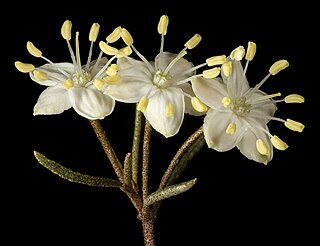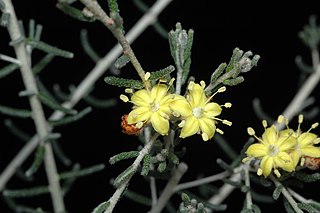
Phebalium daviesii, commonly known as St Helens wax flower or Davies' wax flower, is a species of shrub that is endemic to a restricted area in Tasmania. It is more or less covered with silvery or rust-coloured scales and has narrow wedge-shaped leaves with a notched tip, and umbels of white to cream-coloured, five-petalled flowers.

Phebalium bullatum, commonly known as silvery phebalium, desert phebalium or sand phebalium, is a species of shrub that is endemic to southern continental Australia. It is more or less covered with silvery scales and has narrow oblong to narrow wedge-shaped leaves and yellow flowers in umbels of about six.

Phebalium squamulosum , commonly known as scaly phebalium or forest phebalium, is a species of shrub or slender tree that is endemic to eastern Australia. It has smooth branches covered with rust-coloured scales, linear to elliptical or egg-shaped leaves with the narrower end towards the base, and pale to bright yellow flowers in umbels with rust-coloured or silvery scales on the back.

Phebalium nottii, commonly known as pink phebalium, is a species of shrub that is endemic to eastern Australia. It has branchlets with silvery scales, oblong to elliptical leaves, deep pink to mauve flowers arranged in umbels of up to six, with the stamens distinctively offset to one side of the flower.

Phebalium glandulosum, commonly known as desert phebalium, is a species of shrub that is endemic to eastern Australia. It has glandular-warty stems covered with silvery to rust-coloured scales, wedge-shaped leaves that are scaly on the lower surface, and yellow flowers arranged in umbels on the ends of branchlets.

Phebalium canaliculatum is a species of erect shrub that is endemic to the southwest of Western Australia. It is more or less covered with silvery and rust-coloured scales and has thin, cylindrical leaves and dark pink to pale mauve flowers in umbels on the ends of branches.
Phebalium bifidum is a species of small, erect shrub that is endemic to the Capertee Valley in New South Wales. It is more or less covered with glossy scales and has bilobed leaves and cream-coloured to bright yellow flowers arranged in umbels on the ends of branchlets.
Phebalium brachycalyx is a species of shrub that is endemic to the southwest of Western Australia. It is more or less covered with silvery and rust-coloured scales, and has narrow oblong leaves with wavy-glandular edges, and white to pale yellow flowers in umbels on the ends of branches.
Phebalium brevifolium is a species of small shrub that is endemic to Western Australia. It has warty branchlets, sessile, wedge-shaped leaves and up to three white flowers arranged in umbels.
Phebalium clavatum is a species of shrub that is endemic to Western Australia and is more or less covered with silvery scales. It has warty branchlets, more or less circular leaves with a large spherical gland and white flowers arranged singly on the ends of branchlets.
Phebalium drummondii is a species of small shrub that is endemic to Western Australia. It has smooth branchlets covered with silvery scales, broadly elliptic to egg-shaped leaves with silvery scales on the lower side and bright yellow flowers arranged in umbers on the ends of branchlets.
Phebalium elegans is a species of spreading shrub that is endemic to Western Australia. It has warty branchlets, wedge-shaped leaves and two to five white flowers arranged in umbels on the ends of branchlets.

Phebalium festivum, commonly known as dainty phebalium, is a species of spreading shrub that is endemic to Victoria, Australia. It has smooth branchlets, broadly egg-shaped, warty leaves and three to ten white or pale yellow flowers arranged in umbels on the ends of branchlets.

Phebalium filifolium, commonly known as slender phebalium, is a species of upright, rounded shrub that is endemic to Western Australia. It has smooth branchlets covered with silvery scales, more or less cylindrical leaves with silvery scales on the lower side and pale to bright yellow flowers arranged in umbels of between three and eight on the ends of branchlets.
Phebalium laevigatum is a species of erect, slender shrub that is endemic to Western Australia. It has glandular-warty branchlets, linear to narrow oblong leaves and white or yellow flowers arranged in umbels of about seven on the ends of branchlets.

Phebalium lepidotum is a species of rounded shrub that is endemic to Western Australia. It has scaly branchlets, leathery, narrow oblong leaves and white to cream-coloured flowers arranged in umbels of between three and six on the ends of branchlets.

Phebalium lowanense, commonly known as the Lowan phebalium, is a species of slender shrub that is endemic to southern continental Australia. It is more or less covered with silvery and rust-coloured scales and has leaves appearing to be cylindrical, and yellow mauve flowers in umbels on the ends of branches.

Phebalium megaphyllum is a species of erect, rounded shrub that is endemic to Western Australia. It has glandular-warty branchlets, oblong to wedge-shaped leaves with a groove on the upper surface, and white flowers arranged in umbels of three to six on the ends of branchlets.
Phebalium microphyllum is a species of small, rounded shrub that is endemic to Western Australia. It has scaly branchlets, leathery, oblong leaves and yellow flowers arranged in umbels of three to six on the ends of branchlets.
Phebalium obovatum is a species of spreading shrub that is endemic to Western Australia. It has thick, egg-shaped or elliptical leaves densely covered with silvery scales on the lower side and white flowers arranged in umbels with silvery or rust-coloured scales on the back.











